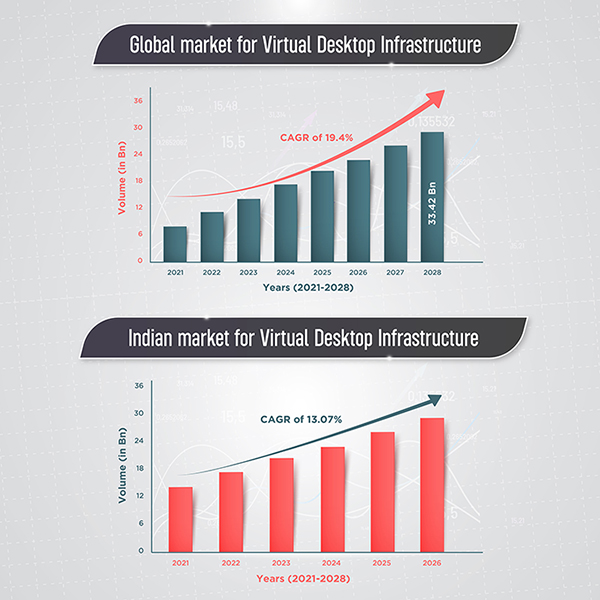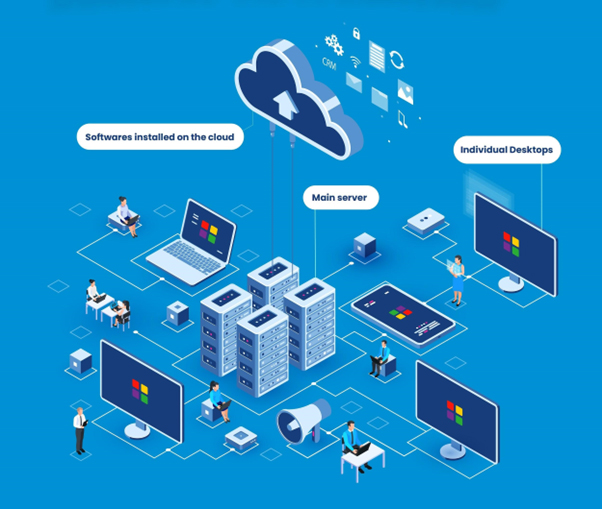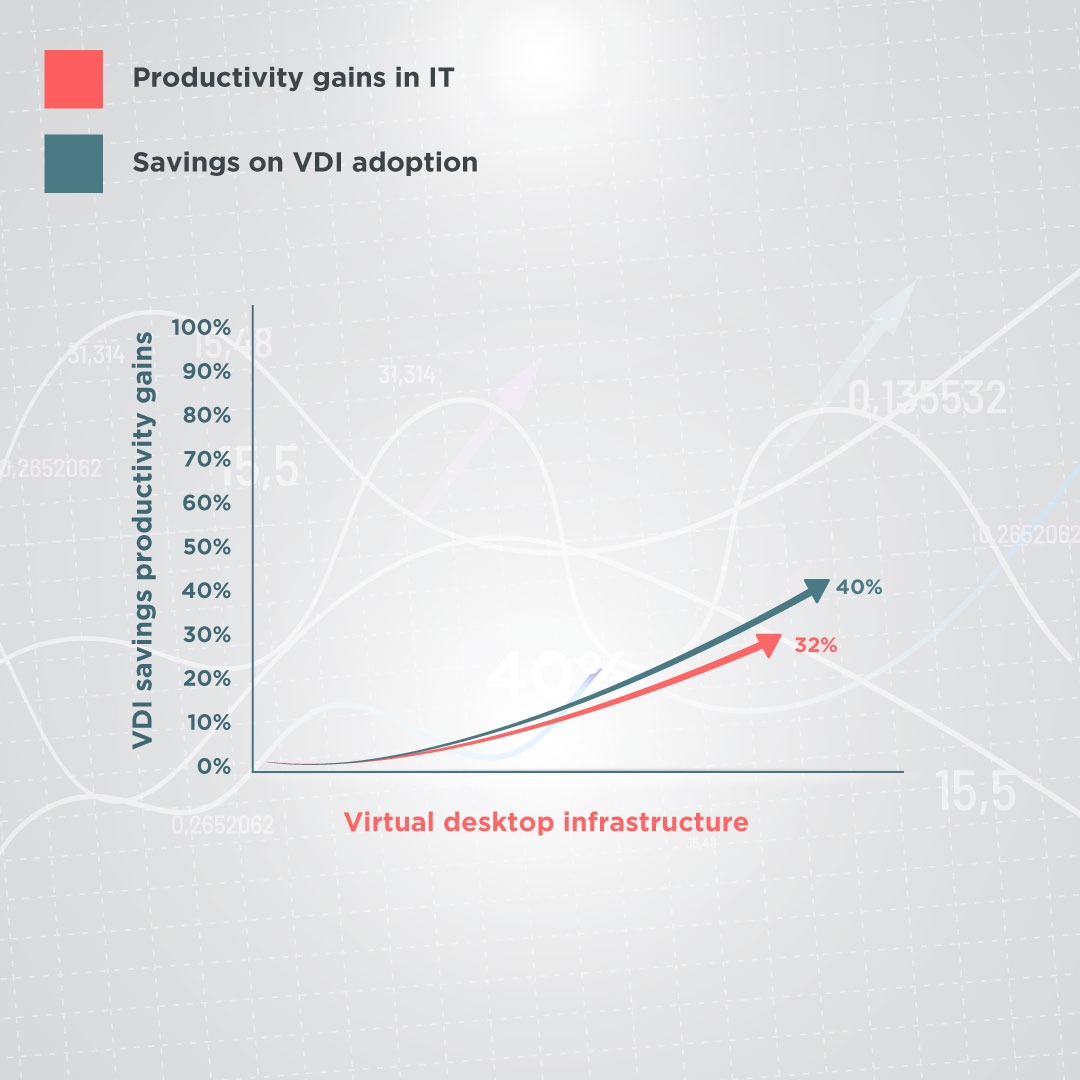

The digital workspace trend post-COVID is here to stay. As an increasing number of employees prefer working from home or a hybrid working model, Small and Medium Enterprises (SMEs) must be ready to enhance their IT infrastructure making it suitable for all. While the overall infrastructure changes needed to accommodate a hybrid work setup can seem like a daunting task, there is a flexible and effective solution that all business owners can implement easily.
Desktop on Cloud, gives businesses a great opportunity to offer flexibility of working, increase data security, improve manageability, and convert their onetime capital expenses to a monthly outflow. This option leaves more cash in hand for MSME to use it for business use rather than for building office infrastructure.

Not surprisingly, the global market for Virtual Desktop Infrastructure is expected to grow at a CAGR of 19.4% during 2021-2028 to touch USD 33.42 Billion by 2028. In India too, a report from Mordor Intelligence suggests that the Indian desktop virtualization market is likely to register a CAGR of about 13.07% between 2021-2026.
Desktop on Cloud, as the name suggests, primarily allows for setting up virtual desktops for your employees which can be accessed from anywhere. Traditionally they are setup in on premise datacentres but with the evolution of technology, Desktop on Cloud can also be deployed on clouds which gives the SMEs the benefit of leveraging the entire stack of IT infrastructure.

These computer terminals can be considered individual machines that use the resources housed inside a central server, unlike their traditional counterpart that stores data on a hard drive. The infrastructure, i.e., all the company data, settings, and applications, are hosted on a cloud, allowing for centralized management and control. Once employees access these individual workstations or terminals, they receive all the required tools to get them started.
As per a Forrester case study, a VDI environment helped achieve productivity gains of 40% in IT support as compared to a traditional desktop environment. In additional to substantial savings from direct end user device costs avoidance and software costs, the case also showed an ROI of 32% on VDI adoption.

Desktop on Cloud makes hardware a cost-effective process for SMEs. You can also save up on expensive multiple individual application licenses as the centralized solutions make it easier for businesses to own these licenses. It is equally easier to scale up and down depending upon organization requirements, providing greater flexibility with pay-as-you-use plans. As SMEs with limited IT budgets, this allows for appropriate expense allocation.
The overall energy consumption is yet another advantage with Desktop on Cloud. Due to an optimised use of hardware, the energy consumption for small and medium businesses is comparatively lower than traditional methods. This means reduced cost for buying software and tools and even low upkeep cost of electricity and energy needed to run the whole infra setup.
Data security is always a concern, no matter the size of your company. With Desktop on Cloud, organisations enjoy a secure connectivity channel compared to a personal/ professional OS device. As the basic machine lacks any operational capabilities other than its function to connect with the server, any possibility of exploiting this terminal is eradicated. In a hybrid/work-from-home environment, Desktop on Cloud also provides a reliable way for administrators to ensure data is not exploited by any agent keeping all confidential information in safe hands.
With administrators and employers having complete control and visibility over information transfer, issues related to information security are curbed to a minimal extent. Without the need for extensive manpower or resources deployed to monitor data in the traditional method, Desktop on Cloud optimises security costs for organisations and employers.
Even after adding layers of security, the persistent threat of virus attacks can create havoc on your data. Desktop on Cloud enables automated backups regularly. Employees do not save significant data on their local devices when desktops run on the cloud. Therefore, no data that is kept on their hardware needs backup. By doing so, you spare your IT department the time-consuming task of setting up backup software on employees' devices. The desktop environments of each user can also be backed up, but since they are hosted in the cloud and run on virtual machines, backup is much easier.
Administrators can access this cloud backup easily at any time and restore data for a particular desktop or the central server as a whole.
Additionally, if any of the employees stumble into a malicious website, infecting their virtual machine (VM) with ransomware, all of their data and encryptions can be at risk. In such cases, the user’s VM or desktop can be isolated from the rest of cloud. Your end user, the most common attack vector, is isolated, under your control, and contained in the cloud. If you provide users email or web access through an application or browser installed on a cloud desktop, any ransomware or other dangerous content is restricted to that cloud desktop. Ransomware won't have a chance to hold your data ransom if you lock that desktop away from your corporate data and delete it as soon as the user logs out.
This not only prevents the ransomware attack from spreading to other devices but also saves crucial data from getting lost.
One of the key features of Desktop on Cloud is its ability to connect from personal devices, also termed as Bring Your Own Device (BYOD). With BYOD, SMEs can transform their working infrastructure into a secure and reliable model in a work at home/hybrid situation. Backed with a flexible security guideline that enables a quick process to introduce personal devices, the Desktop on Cloud focuses on many key advantages such as PCI Compliance, End Point Validation, and Automated Backup, which amplify the efficiency of using a virtual infrastructure and reduces the risk of losing your business-critical data.
Desktop on Cloud allows simplified central management since IT administrators can virtually operate multiple desktops remotely. The admin team and management have the power to manage, troubleshoot, update software and profiles, and implement security settings on their entire environment from a single console, giving them complete access to the working network.
This allows them to install new applications or update existing ones with little to no downtime for the employees. It also makes troubleshooting issues a lot easier with lesser turnaround time since employees do not have to turn in their physical machines. Admins can also monitor the usage and allocate resources accordingly to meet business requirements.
Patch updates help eliminate bugs and promote productivity for teams. However, individually resolving these vulnerabilities for each desktop can be a long process involving a pool of resources and time. With Desktop on Cloud, the central server takes care of all the updates together and makes bug management and patch updates much faster. Additionally, this centralized patch management strategy is more cost-effective and security-focused because of Desktop on Cloud’s unified infrastructure.
Desktop on Cloud allow employees to access their desktops from anywhere and from any device. Since the hardware requirements are now handled virtually, they can be more flexible and use devices like smartphones and tablets to access their workspace. This also allows for easy access to third-party contractors, freelancers and other distributed organizations which SMEs commonly use.
While amping up the end-user experience, it also speeds up boot time and provides 24/7 live OS accessibility for the users.
It is successful in reducing all costs caused by the downtime associated with any environment, including work at home. With access to a Validation Tool, all agent onboarding processes have reduced it from over an hour to under 10 minutes. With the addition of the Single Click Installer, the installation time, which is ideally a time-consuming event, is enhanced into a 'ready to go' process that commences work almost immediately.
By minimizing the amount of power or energy your business consumes in various ways, implementing Desktop on Cloud can assist you to reduce carbon footprint and lower carbon emissions. You reduce physical energy consumption by default as it enables hybrid work environments.
In addition, as your employees can shift to less demanding devices, they produce significantly lower levels of heat. They are typically lighter and smaller than conventional desktop PCs, which implies that producing them requires less energy and resources. Since cloud services frequently use cutting-edge data centres that use more sophisticated technologies to preserve resources and minimize waste at every level of operations, they can help your company consume less energy. As a result, your enterprise benefits from a lower carbon footprint.
With a host of benefits that Desktop on Cloud offers, this IT infrastructure model is being adapted by SMEs all around the country. It is also able to solve all operational, technological and security challenges in a multi-disciplinary work style making it easier for SMEs and helps you to focus on your business growth. Interested in learning how Desktop on Cloud can enhance your business?
Come check out our offerings and take your business to the next level.

 Request a call back
Request a call backThank you for sharing your details.